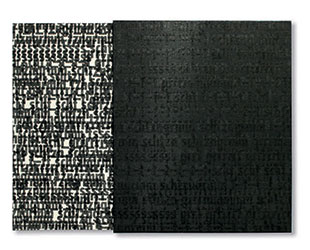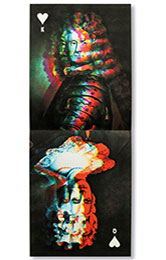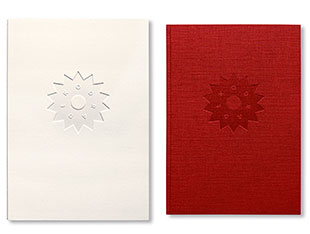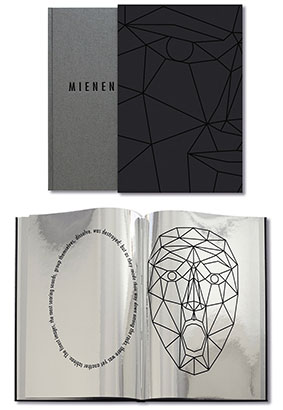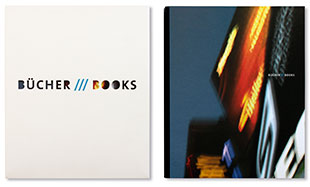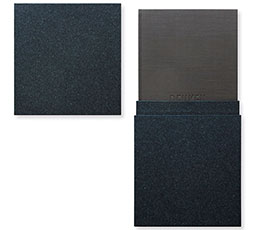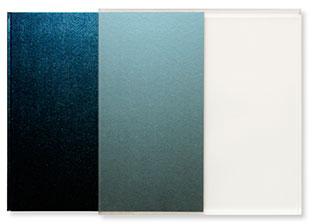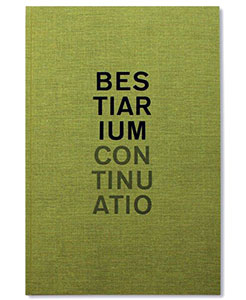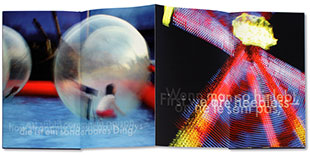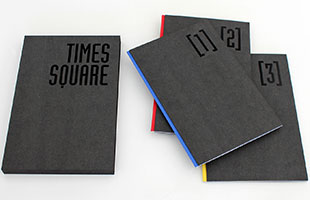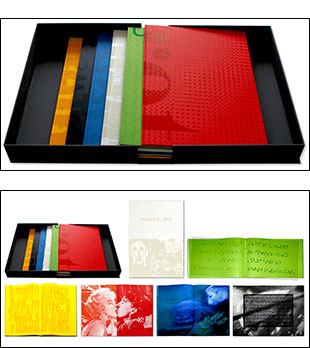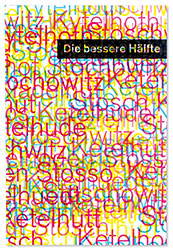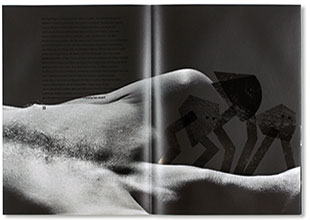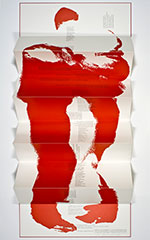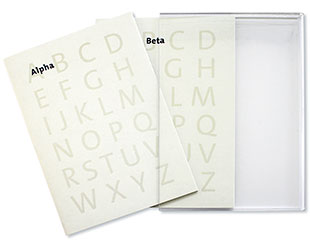
|
Ines von Ketelhodt
~Germany |
Share this page: |
| Artist statement: " Ines von Ketelhodt studied 'Visual Communication' at the University of Art and Design in Offenbach/Germany. Since 1986 she works in the fields of photography, typography, artist’s books and graphic design. She was a co-founder of the book artists’ collective 'Unica T' (1986–2001). From 1997 to 2006 she worked together with Peter Malutzki on the fifty volumes book art project 'Zweite Enzyklopädie von Tlön'. In 2002 she moved to Flörsheim/Germany and opened a joint workshop with Peter Malutzki. Her main interests include: experimental typography; experimental photography (such as long exposure time, taking photographs by chance); combination of photography and typography; combination of old and new techniques (such as letterpress, original photographic prints, offset and digital printing)." | |
Ernst Jandl, schtzngrmm Design by Ines von Ketelhodt. Hand-set (Futura Bold Condensed), letterpress. Bound in printed cloth-covered boards (18.2 x 21.2 cm). Housed in a printed cloth-covered slipcase (18.8 x 21.7 x 1 cm) with glassine and black paper. 78 pages. Numbered and signed by the artist. Ines von Ketelhodt: “The text belongs to the tradition of concrete poetry and is one of the antiwar poems of the 1960s. The printed pages of the book have been ‘injured,’ with 72 holes burned into them that evoke bullet holes. “This poem consists entirely of the word ‘Schutzengraben’ (trench); in the Viennese dialect, when all of the vowels are removed, it becomes ‘schtzngrmm’. The consonants rearrange themselves into new syllables that evoke machine-gun volleys and grenade strikes, painting an onomatopoetic picture of trench warfare. “The 32 lines of the poem are distributed across the pages of the book. Each page has only one line. Because of the transparency of the glassine paper, the previous and subsequent lines show through. The text is reversed on each left-hand page, and legible on each right-hand page. “Ernst Jandl can be heard reciting his sound poem in an audio recording from 1995 . |
|
Patience 14 x 17.5 cm closed, extends out to 3,7 m; 40 pages. Double-sided accordion with printed paper covered boards. Pictures edited in Photoshop and printed using Giclée technology (11colors). Text (Futura Light Condensed) letterpress printed. Housed in a plexiglass box with lid (15.4 x 18.9 x 1.9 cm), Bamboo Paper from Awagami Factory. Numbered and signed by the artist. Ines von Ketelhodt: "’Patience’ (the French name for the card game of ‘solitaire’) is an accordion made from 18 assembled playing cards. Each card shows a married couple, facing each other as if in a mirror. The 36 portraits are ancestors of my mother and are based on paintings, copperplate engravings, and original contemporary photographs from the 17th through 19th centuries. Each portrait is assigned a card symbol (spade, club, diamond, heart) in combination with a Roman numeral I-X or a letter: Q(ueen), K(ing), or J(ack). The couples are assigned roles from the playing-card procession in Lewis Carroll's ‘Alice's Adventures in Wonderland.’ The relevant text passage (in the original English) precedes the playing cards as a motto, or possibly a form of card-game instructions. At the end of the accordion is a list of the names, birth and death dates of the 36 playing-card ‘actors’." “[...] First came ten soldiers carrying clubs; these were all shaped like the three gardeners, oblong and flat, with their hands and feet at the corners: next the ten courtiers; these were ornamented all over with diamonds, and walked two and two, as the soldiers did. After these came the royal children; there were ten of them, and the little dears came jumping merrily along hand in hand, in couples: they were all ornamented with hearts. [...] turning to Alice, the Queen went on, ‘What's your name, child?’ ‘My name is Alice, so please your Majesty,’ said Alice very politely; but she added, to herself, ‘Why, they're only a pack of cards, after all. I needn't be afraid of them!’ […]" |
|
Die Sorge des Hausvaters Embossed cloth-covered boards (28.6 x 19.9 cm) housed in a paper-covered clamshell box (29.8 x 20.7 x 1.8 cm), glassine paper (50 g/m2), Zerkall mouldmade paper (115 g/m2), 96 pages. Design, hand-set, letterpress and bookbinding by Ines von Ketelhodt. Numbered and signed by the artist. Ines von Ketelhodt: "Franz Kafka's story is about a strange thing - or creature - called ‘Odradek.’ At first glance it looks like a flat star-shaped spool for thread, and indeed it does seem to have thread wound upon it; to be sure, they are only old, broken-off bits of thread, knotted and tangled together, of the most varied sorts and colors. But it is not only a spool, […] Odradek is extraordinarily nimble and can never be laid hold of. […] Am I to suppose, then, that he will always be rolling down the stairs, with ends of thread trailing after him, right before the feet of my children, and my children's children? He does no harm to anyone that one can see; but the idea that he is likely to survive me I find almost painful. “Kafka's text is broken down into short phrases and spread out across all the pages of the book. There is only one line per page. Due to the transparency of the glassine book pages, the phrases on the following pages show through. The switch to individual lines seems to have interrupted the narrative thread, so that one ‘loses the thread’ while reading. “In order to stitch the narration back together and to create a complete textual fabric, the individual text segments are connected by a piece of red thread about 8 meters (26 feet) long. From one page to the next, the red silk thread pierces the glassine paper and ultimately continues through the entire book, connecting the line of text on each page with the following one. “When the book is opened, the reader sees not only a space with lines of text in differing lengths, but also the red thread, which ‘moves with’ the pages each time they are turned. Thus, the reader/viewer is constantly changing the appearance of the double pages while turning the pages.” |
|
Mienenspiel 17.1 × 25.4 cm; 40 pages. Face illustrations and texts letterpress printed with polymer plates on Chromolux paper, which is coated on one side with aluminum. Reverse and uncoated side of the papers glued together along the front edge. Embossed cloth-covered boards. Housed in a paper-covered slipcase (17.4 × 26 × 1.5 cm). Design, face illustrations, letterpress and bookbinding by Ines von Ketelhodt. Signed and numbered by the artist. Ines von Ketelhodt: "The book investigates the wide range of human facial expressions and the topic of facial recognition. Thanks to the mirror effect of the paper, which is coated in silver foil, viewers see themselves in the book as they turn the pages. They can imitate the illustrations of facial expressions that are printed on the foil, and modify their reflected images accordingly. "The text passages from Georg Büchner's 'Lenz' (1839) describe 'all the subtle, barely noticed play of facial features,' 'the human nature,' respect and tolerance for individuals, the 'unique existence of each being,' as well as Medusa's head. The original German text is printed on each right-hand page, with an English translation on the left. The texts are set around an oval shape that is reminiscent of a mirror or even a face. Viewers can read the text by turning the book counter-clockwise. This also changes the reflected surroundings of the double-page spread." Mienenspiel = Facial Recognition, Graphic Arts Collection, Princeton University(as of 9/8/2020): " In 1839, Georg Büchner published Lenz, a ground-breaking novella about schizophrenia. In 2020, Ines von Ketelhodt designed and published Mienenspiel, incorporating sections of Büchner’s text onto its reflective pages, placing the reader/viewer in the uncomfortable position of being outside and inside the book at the same time. "The German dramatist and novelist Georg Büchner (1813-1837) died at the sadly young age of twenty-four, leaving the question of what he might have accomplished had he lived longer. In 1828 he became interested in politics and joined a group which later on probably became the Gießen and Darmstadt section of the 'Gesellschaft für Menschenrechte' (Society for Human Rights). In 1835, his first play, Dantons Tod (Danton’s Death) about the French revolution was published, followed by Lenz, a novella based on the life of poet Jakob Michael Reinhold Lenz. "Lenz, Georg Büchner’s visionary exploration of an 18th-century playwright’s descent into madness, has been called the inception of European modernist prose. Elias Canetti considered this short novella one of the decisive reading experiences of his life, and writers as various as Paul Celan, Christa Wolff, Peter Schneider, and Gert Hofmann have paid homage to it in their works. Published posthumously in 1839, Lenz provides a taut case study of three weeks in the life of schizophrenic, perhaps the first third-person text ever to be written from the 'inside' of insanity. An early experiment in docufiction, Büchner’s textual montage draws on the diary of J.F. Oberlin, the Alsatian pastor who briefly took care of Lenz in 1778, while also refracting Goethe’s memoir of his troubled friendship with the playwright.” |
|
Ines von Ketelhodt _ Bücher /// Books 23 x 28 cm; 192 pages. Bilingual text (German/English). Thread-stitched brochure with fabric spine. Printed slipcase with stamped title. Artist's Statement: "Since the late 1980s, Ines von Ketelhodt has worked in the genre of the artist's book, and her work is represented in many international collections. She gained special attention for her 50-volume project 'Zweite Enzyklopädie von Tlön' [Second Encyclopedia of Tlön], which she produced in collaboration with Peter Malutzki from 1997 to 2006. An extensive catalog has already been created for this project. Now a catalog is available for her 'pre- and post-encyclopedic' work. In addition to 420 pictures and detailed descriptions of all her books since 1987, the catalog also includes essays by Paul van Capelleveen (Koninklijke Bibliotheek, National Library of the Netherlands, The Hague), Dr. Viola Hildebrand-Schat (Frankfurt/Main, Germany), Ruth R. Rogers (Wellesley College, Clapp Library, Wellesley, MA, USA) and Dr. Stefan Soltek (Klingspor-Museum, Offenbach/Main, Germany." |
|
Denken / Gehen 18 x 38.8 cm; 40 pages. Photography, hand-setting, letterpress, and bookbinding by Ines von Ketelhodt. 20 black and white photographs. Triplex-offset printed on Zerkall mould-made paper. Embossed cloth-covered boards. Housed in a paper-covered 19.5 x 40 x 2.6 cm case with lid. Numbered and signed by the artist. Ines von Ketelhodt: "Photographs of mountain paths, taken in 1999 with an SLR camera at Coll de Rates in Spain, are mirrored in two directions in the book - once skyward, once earthward - and refer in a sense to 'thinking' and 'walking'. The photographs show what the walker sees: a deserted landscape. The text passage from Thomas Bernhard's story 'Gehen' [Walking] is letterpress printed on the blue-black triplex images in 24-point bold condensed Futura, at various skewed angles." Walking text passage by Thomas Bernhard: ""(…) We say of one person he is an excellent thinker and we say of another person he is an excellent walker, but we cannot say of any one person that he is an excellent (or first-rate) thinker and walker at the same time. On the other hand walking and thinking are two completely similar concepts, and we can readily say (and maintain) that the person who walks and thus the person who, for example, walks excellently also thinks excellently, just as the person who thinks, and thus thinks excellently, also walks excellently. (…)" |
|
Poissons Forgerons – Schmiedefische 30.2 × 30.3 cm; 72 pages. Text in German and French. Photography, hand-setting, letterpress, and bookbinding by Ines von Ketelhodt. Bound in iridescent metallic coated paper. Slipcase of semi-transparent white acrylic. Numbered and signed by the artist. Ines von Ketelhodt: "The book 'Poissons Forgerons – Schmiedefische' [Forge Fish – Fish of the Forge] contains fish photographs, which are taken in the aquarium at the Frankfurt Zoo. They are placed in relation to a text by Michel Butor, 'Almageste, jungle/Almagest, Tarnfarbe,' in the original French as well as in a German translation. The entire text is printed on green paper in 16-point Akzidenz-Grotesk, and precedes the photographs. "One sentence is emphasized and stretches across all the pages of the book: 'They know that they are constantly being watched from the room, and in their silky caves they dream of making the leap that, in just a few centuries, will allow them to snatch up these intruders and stir them into their soup.' This sentence is letterpress printed in 60-point Akzidenz-Grotesk in various shades of green and blue on the backs of the photographs, which are offset printed on translucent paper." |
|
Bestiarium Continuatio 29.4 x 19.2 cm (11.6 x 7.6); 64 pages. Photographs offset printed on one side of a sheet of glassine paper with letterpress printing of the text on the other side. Photography, handset, letterpress, and bookbinding by Ines von Ketelhodt. Bound in printed paper over boards. Signed and numbered by the artist. Ines von Ketelhodt: "This book contains animal photographs that were taken of dioramas and stuffed animal specimens in the American Museum of Natural History in New York and Museum Wiesbaden, as well as a passage from the ninth chapter of Hans Jakob Christoffel von Grimmelshausen’s 'Continuatio des abentheurlichen Simplicissimi' (1669) about the changeable mythical figure 'Soonchanged'. It also contains an encrypted secret text. "The animal images each take up a double spread of the book, with one half of the animal on the left-hand page and the other half on the right-hand page. When the page is turned, it produces a new combination with the next animal – a hybrid creature. The new animal then merges with the following animal, and so on. The entire book represents an ongoing chain of transformation, each hybrid creature becoming a new one each time a page is turned." |
|
Zeit/Temps/Time 24 x 14.2 cm (9.4 x 5.6") closed, extends to 183 cm (72"); 30 pages. Double-sided accordion. Digital printing. Photography, design, and bookbinding by Ines von Ketelhodt. Bound with cloth-over-boards. Embossed label on front board. Signed and numbered by the artist. Ines von Ketelhodt: "This accordion book shows two photographic series of two different motifs, taken in Vienna’s Prater amusement park. Both motifs, which alternate rhythmically in the concertina book, address the themes of movement, circles, and time. The photographs include a text passage from Act One of Hugo von Hofmannsthal’s play 'The Cavalier of the Rose' (1911), in the original German version, as well as a French and an English translation: 'Die Zeit, die ist ein sonderbares Ding / Le temps est subtil comme un poison / Time – how strangely does it go its ways'. "The texts come in various sizes and levels of transparency, overlapping with each other in the photographs." Ines von Ketelhodt, translation of The Cavalier of the Rose: "Time – how strangely does it go its ways. First we are heedless – Lo! ’tis as nothing! Then a sudden waking, and we feel nothing else but it, all the world tells of it, all our souls are filled with it. No face but shows the mark of it, no mirror but shows it to us, all my veins feel its throbbing. And there, ’twixt you and me, it flows in silence, trickling like the sand in an hour-glass." |
|
Times Square 1-2-3
$850 |
|
| Farbwechsel: weiß, gelb, grün, blau, rot, schwarz By Ines von Ketelhodt Flörsheim, Main, Germany: Ines von Ketelhodt, 2011 - 2013. Edition of 33. 43.7 x 30.7 x 7.4 cm (17.2 x 12.1 x 2.9")'; six books in a printed cloth-covered clamshell box. The six books have an identical format (41.8 x 29.4 cm / 16.5 x 11.6"). White: 56 pages, bound in printed paper over boards with printed linen spine. Yellow: Handset and letterpress, 88 pages, bound in printed paper over boards. Green: 64 pages, bound in printed paper over boards with linen spine. Blue: 32 pages. Red: Photographs printed with polymer plates in letterpress using inks in several "lipstick" colors; 60 pages, bound in printed paper over boards. Black: 32 pages, vat paper, printed paper over boards. Processes: photography; hand composition; polymer plates; letterpress; offset; and digital printing. Signed and numbered. Ines von Ketelhodt: "The project farbwechsel/color change consists of six books … Each book is dedicated to a single color. Starting out from classic color theory I placed the colors yellow, green, blue and red between white and black. The project gave me an opportunity to work on the subject of color in different ways. I assigned appropriate topics, text, and pictures to the individual colors, with photography, printing ink and colored papers playing a role. The six books have an identical format (about 17 to 12 inches), but differ in their handling. Some are horizontal, some upright format, one is a concertina. "farbwechsel: weiß - In Eastern cultures white is the color of mourning and death. The white volume contains photographs and headlines about the tsunami disaster that struck Japan on March 11, 2011. They were taken from international online newspapers and were collected from March 11, 2011 to March 11, 2012. The selection includes many different voices from various countries and languages. The photographs (polymer plates) and handset dates (72 point, condensed Block) were printed in letterpress with white ink on white paper. In spite of the different white shades of paper and printing ink, the monochrome white/white print result is difficult to read. This was obviously my intention and is an important aspect of the book. The twenty-four explanatory headlines of the respective dates, I have used in their different languages, appear together on a spread at the end of the book … "farbwechsel: gelb - The yellow book contains a complete chapter by H. C. Artmann tale Die Sonne war ein grünes Ei ('The sun was a green egg' in German original). It's a funny surrealistic genesis about the creation of the world and its objects. It is about the jealous relationship of sun, moon and a certain object, as well as the genesis of stars and falling stars. As not more than five or six of the large wooden letters fit into a line, I couldn't break the lines by dividing words according to syllables. Printed with yellow ink on yellow paper the text at first sight seems more like a pattern, but it is still legible. It was this ambivalence that interests me in the book: type face as a vehicle for content and type face as pure shape or texture. … "farbwechsel: grün - It contains a text passage by Virginia Woolf's To the Lighthouse (in English/German) … In the green book I have tried to visualize the topic of dissolved shapes, abstract symbols, the recognition of a letter's shape and the form of words. All letters were cut individually into two parts so that the fragments of each letter look different. Then the two fragment levels were printed digitally in different shades of green onto two transparent foils. Finally in the bound book they are lying over each other, but the fragments are a bit shifted, so the reader can shift the foils until they converge, thus making the text legible. Practiced readers are able to complete even heavily fragmented letter shapes through cognitive supplementation, while reading. "farbwechsel: blau - The blue book contains a poem by Hans Arp 'Himmelblaue Seelen/Sky-blue souls' (in German) and photographs, which were taken with long exposure times in the aquarium of the Frankfurt zoo. Time exposure captures a phase of time that we normally cannot perceive. Movements are blurred, they dissolve in time. Fish that moved slowly or remained in a position, are more easily recognized in the picture, than those, that were swimming fast. Even though the fish were there and swam through the picture, they can sometimes completely disappear, not leaving any 'light'-trace. Their time within the field of view was too short, to form an image on the sensor of my camera. The photographs are printed in offset, the poem in letterpress using transparent ink. So the text gets its color by the underlying photograph. The glossiness of the transparent ink lets you easily read the type face on the photographs. "farbwechsel: rot -Inspired by Giuseppe Tornatore's movie Cinema Paradiso I began collecting kiss scenes for the red book. The movie is set in a small catholic village in Italy during the forties. It is about the history of cinema and movie. And there is this wonderful story about censored kiss scenes. For the red book I took kiss photographs from the television screen. My idea was that in the book all women should kiss all men and all men should kiss all women. New couple combinations are created with Lauren Bacall, Diane Baker, Humphrey Bogart, Charlie Chaplin, Tony Curtis, Audrey Hepburn, Marilyn Monroe, Peter O'Toole, Gregory Peck and Elizabeth Taylor ('Some Like It Hot', 'To Have and Have Not', 'How to Steal a Million', 'Mirage', 'The Kid', 'Cleopatra'). "farbwechsel: schwarz - The black book is a concertina (31 feet) printed on both sides. The black-and-white photographs were taken while wandering through the city of Frankfurt, Germany without looking through the view finder of the camera. Chance as well as the trajectory and bodily movement of the stroller define the picture's viewpoint. 'La Notte' a text by Giorgio Manganelli gave me the inspiration for the book. … Said cuboid-shape gave me the idea to print a slightly translucent black letterpress rectangle with a polymer plate onto my offset-printed night photographs. The significantly darker letterpress-black creates a second level on the offset photograph. But the photograph beneath is still visible through the overprint. Manganelli's text (in Italian and German) appears in some of the black rectangles. The type face is negative on the polymer plate and seems on the print sometimes lighter, sometimes darker due to the structure of the photograph beneath, shaped by the picture." $4,900 |
|
| Die bessere Hälfte - eine Ahnengalerie [The better half - a gallery of ancestral portraits] By Ines von Ketelhodt Flörsheim, Main, Germany: Ines von Ketelhodt, 2010. Edition of 50. 20.3 x 29.6 cm (8 x 11.7"); 112 pages. Photographs edited digitally. Printed on parchment paper. Design, handset, letterpress by Ines von Ketelhodt. Bound in printed paper over boards. Signed and numbered by the artist. Ines von Ketelhodt: "Pictorial history of the artist's ancestry dating back to the 13th century, starting with her maternal ancestors leading in direct line to herself together with her husband Peter Malutzki. The following pages show her paternal ancestors. The portrait photographs were taken from paintings, drawings, etchings, and epitaphs or out of family photo-albums. The individual portraits were divided in the center and set together with their spouse to let the 'better halves' form a 'new person'. If a portrait is missing, the personal information ghosts through in reverse, as the respective names and dates of birth and death are printed in letterpress on the back of the portraits. Forming a further layer, historic dates from the 13th to the 21st century are set in relation to this data. The historic dates from all over the world are vertically printed in letterpress in a smaller font." $450 |
|
Unser Landschaftsbericht 17 x 24 cm (6.7 x 9.4"); 44 pages. Double-sided concertina. 22 photographic prints on Agfa Paper. Handset and letterpress printed. Bound in stiff paper boards with titles on front cover. Signed and numbered by poet and artists. Ines von Ketelhodt: "Unser Landschaftsbericht was a collaboration with Peter Malutzki. The title came from a text by Peter Rosei (a description of a surrealistic landscape), which we printed in its entirety on original black-and-white photographs by Ines. First we had to make all of the original photographic prints for the edition. There were 22 pictures per copy, about 1,500 in total. Our bathroom was constantly blockaded, and there were pictures hanging up to dry everywhere. The photos showed body parts of naked women and men, barely recognizable as such because of the way the images were cropped. They are more reminiscent of hilly landscapes; lined up alongside one another in the accordion, they do actually create a landscape that extends throughout the whole accordion book. The accordion has one light side and one dark side. The dark side consists of positive prints of the photos, and the light side of contact prints of the positives. Thus the light-colored photographs are negatives. In fact, the two sides look like day and night shots. We had decided to do this because there are also day and night images in Rosei’s text. Peter inserted letterpress figures into the imaginary landscape (printed with polymer plates, brass rules and various type materials), some of them acting as signs within the landscape, sometimes simply showing the page number but also creating figurative elements. They are not always visible at first glance on the dark pages, since they are letterpress printed in black onto the dark photo paper. But when the pages are turned slightly so that the light falls on them from a different angle, the shiny shapes are clearly visible." Peter Rosei is a prolific Austrian writer who chronicles the everyday existence of the ordinary and banal in the late 20th and early 21st century. |
|
| Don Juan Text by Karoline von Günderode Book design by Ines von Ketelhodt Offenbach, Germany: Ines von Ketelhodt, 1990. Edition of 50. 16 x 48 cm (6.3 x 18.9"); 10 pages. Accordion binding, printed on one side. Bound in printed linen-over-board cover. Photography, handset, letterpress, and bookbinding by Ines von Ketelhodt. Numbered and signed by the artist. Ines von Ketelhodt: "The silhouette of a kissing scene, printed in red, forms the background for Karoline von Günderode's ballade superimposed in black print. From close up, the 12 point type is legible on an abstract red color field. When the concertina is unfolded and viewed from a distance, the figures appear nearly life-size. The effect is an interplay between closeness and distance." Karoline von Günderode (1780 – 1806) came from a poor but aristocratic family. She felt frustrated by prescribed female roles of her place and time. Romantic poetry became an outlet for these frustrations. $260 |
|
| Ines von Ketelhodt SOLD / Out of Print Titles: | |
Alpha Beta Two volumes: 10.94 x 15.55 x 0.12"; 48 pages. Letterpress printed from polymer plates. Cellophane paper. Plexiglass slipcase (11.26 x 7.99 x .55"). Text in French and German. Ines von Ketelhodt: "The two volumes contain a text passage by Michel Butor that describes a portrait of a universal library. The 'Alpha' volume contains the original French text, 'Itinéraire – Les Bibliothèques,' and the 'Beta' volume features a German translation, 'Reiserouten – Die Bibliotheken' (Itineraries – The Libraries).
"The text could fit onto a single page of each volume, but instead, it is broken down into its letter components. In the spirit of Jorge Luis Borges’ 'Library of Babel,' which he describes as a universal library containing every imaginable book, each of the 26 letters that make up the text is printed separately on its own page in each volume. All of the A/a letters are printed on the first page, all of the B/b letters on the second, etc., with each letter in the same position it would have on a complete printed page. Because of the transparency of the cellophane pages, the entire text can only be read on the first page. On the other hand, the raw material of the separated 26 letters could theoretically be used to create every other possible text. "Another aspect of this book project is the possibility of comparing two languages to one another. If both volumes are paged through at the same time, the reader can compare how frequently various letters appear in the respective languages." Graphic Arts Collection, Rare Books and Special Collections, Firestone Library, Princeton University: "Investigating the visual and conceptual structure of the printed page, Alpha Beta is designed, printed, and bound by the German artist Ines von Ketelhodt. Her matrix is the writing of Michel Butor (1926-2016), a French novelist whose experiments with narrative and structure put him at the forefront of the literary trend known as le nouveau roman (the new novel). "Von Ketelhodt has letterpress printed a passage in which Butor offered a portrait of a universal library: Itinéraire – Les Bibliothèques. In the first volume, it is in Butor’s original French and in the second volume, it has been translated into German. Each letter of the alphabet is confined to one transparent page so that, as the pages are turned, a single letter disappears throughout. By the end, only the punctuation remains on the right, with Butor’s text in reverse on the left. "Transparency is at the core of this volume, printed from polymer plates on to cellophane sheets and housed in a plexiglass slipcase. The text is fluid, both in its narrative and here, even in its physical format." Books on Books Collection reviews "Alpha Beta" |
|
Page last update: 04.02.2024
Home | About Us | Contact Us | New Arrivals | Fine Press & Artists' Books | Broadsides |Resource Books | Order/Inquiry
Copyright © 2021 Vamp & Tramp, Booksellers, LLC. All rights reserved.
